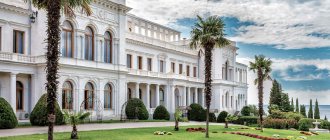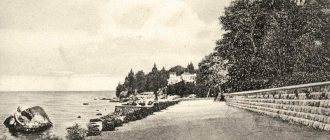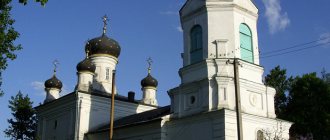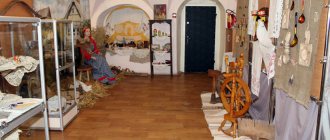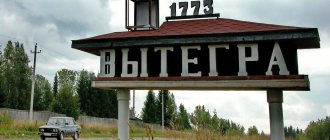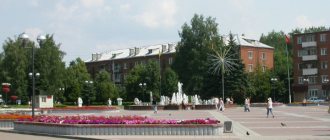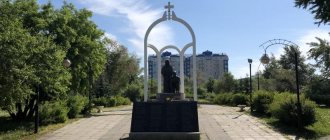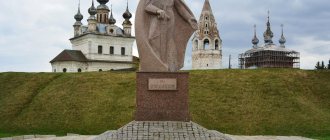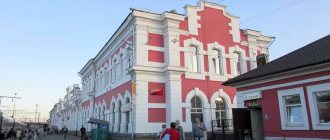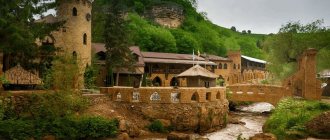Pushkino is a small town 32 km away. from Moscow. But despite such a short distance to Moscow, coming to Pushkino, it’s as if you find yourself in another world - quiet and calm, surrounded by greenery. You can get to it by trains that go from Yaroslavsky station in the direction of Sergiev Posad, Alexandrov, Balakirevo, there are also special express trains “Moscow-Pushkino”. You can also get there by commuter buses, minibuses “Moscow-Pushkino” running from the VDNKh metro station, or by private car along the Yaroslavskoye Highway. The journey by any type of transport will take approximately 40 minutes.
Pushkino
Dacha-museum of the poet Vladimir Mayakovsky
Mayakovsky is another famous writer who loved to spend his free time in Pushkino. A museum was created in the house where he stayed in 1969, but 20 years later it burned down. But this did not stop local residents: the museum was rebuilt and now happily welcomes visitors. In addition to the permanent exhibition, literary readings, lectures and musical evenings are often held here.
Opening hours: daily from 12:00 to 18:00.
Address: st. Akulova Gora, 7, Pushkino, Moscow region.
Mayakovsky's dacha
Sights of Pushkino and its surroundings await tourists
The Moscow region has many colorful places where you can spend a weekend and also bring with you a portion of fresh impressions, souvenirs and discoveries. For example, the city of Pushkino.
For five centuries it has been a dacha complex favored by famous writers, architects and merchants, and now it is worth seeing for tourists. It is especially pleasant to visit the places of Paustovsky, Baratynsky, merchants Evgeniy Armand, Rabenek-Mikhailovs. Inside the merchants' dachas, you can not only appreciate the ancient decoration, but also learn how Pushkino became the center of the weaving industry.
Visit the dacha of the great poet - V.V. Mayakovsky
There are no usual museum things here, and there are no objects from Mayakovsky’s time. The dacha museum is an improvisation museum. For example, in place of the poet’s desk there is a lathe, which serves as a reminder that Mayakovsky “honed” the lines of poems. The employees call the dacha museum an art platform. Exhibitions, master classes, rallies and “battles of poets” are constantly held here.
The museum is open daily from 12:00 to 18:00, but it is better to notify about your visit in advance. Friendly Natalya Pavlovna will meet you and give you a short tour.
Address: Moscow Region, Pushkino, Akulova Gora microdistrict, building 7
+7; https://vk.com/dachamayakovskogo
Visit a former country estate - Pushkin Museum of Local Lore
The museum dates its history back to 1962, but it moved to the building of the former Rabenek-Mikhailov country estate in the early 80s. The estate was once large, with many buildings, but now only this house remains. Moreover, it even survived attempts to demolish it in the 20th century.
They say that ropes were tied to the building, which the bulldozer was supposed to pull, but they could not stand it and broke, and there were no new ropes, so they decided to leave the house. By the time it moved there, the museum had already accumulated about 1,500 exhibits; it took about two years to move them all to the new building. One of the most interesting departments of the museum stores objects found during archaeological excavations in the city.
Also in the museum you can learn about the nature of the Pushkin region, the history of the village of Pushkino, famous figures of literature and art who lived in the city. Part of the exhibition is dedicated to Pushkin’s sister cities, the history of the city and region during the Great Patriotic War.
Address: Moscow region, Pushkino, Moskovsky prospect, 35A
+7 (496) 532‑03-09; https://vk.com/pushkino_muzei
Excursion to the “house of poets” - the Muranovo estate museum
Museum "Muranovo Estate" named after F.I. Tyutchev" is an example of an average-sized noble estate of the 19th century. The ancient estate is located 50 km from Moscow. The poet E.A. lived here for some time. Boratynsky with his family. According to his drawings and plans, a house was built in Muranova in 1842, which has survived to this day.
The family of the poet F.I. also lived in Muranov. Tyutchev, whose family heirlooms and manuscripts were transported to the estate after his death. In 1920, a literary and memorial museum was opened in Muranovo, created by the poet’s son.
Most of the items in the museum's collection are memorial items that belonged to the owners of the estate and their relatives. This is one of the richest collections of furniture in Russian museums, a wide variety of visual materials, and an impressive memorial library with more than 9,000 books.
Address: Moscow region, Pushkinsky district, urban settlement Ashukino, Muranovo village
+7; https://muranovo-museum.ru/ru/
Go to visit the famous author - A.S. Museum Novikov-Priboya
There is a modest street in the village of Cherkizovo near Moscow, named after the Russian writer Alexei Silych Novikov-Priboy. At the very end of it stands, surrounded by greenery, a two-story house. In appearance, it does not stand out in any way from the neighboring houses, but is still worthy of special attention: the author of the historical epic “Tsushima” lived and worked here.
The external and internal appearance of the building has not been altered and has been completely preserved to this day. In 1969, a private memorial museum was opened at the dacha; its keeper, the writer’s daughter Irina Alekseevna Novikova, carefully preserves the memory of her father and conducts excursions for everyone.
Unique photographs and portraits, an interesting story by Irina Alekseevna, the memory of a once-living Russian man with a romantic nautical prefix to his surname and with a desire to improve life - all this cannot leave visitors indifferent. The uniqueness of the exhibition allows you to plunge into the era of a participant in the Battle of Tsushima.
Address: Moscow region, Pushkin city district, Cherkizovo village, Novikova-Priboya street, building 7.
+7; https://novikov-priboy.ru/new/?page_id=1059
See the best products of Orthodox craftsmen - the museum of the Sofrino enterprise
The museum of the Sofrino enterprise presents the best modern products of Orthodox craftsmen and samples of serial production from the first years of the enterprise’s existence. This is a unique production that has no analogues either in our country or abroad. The exhibition also contains items that we are used to seeing in churches. These are altars, candlesticks, chandeliers, lamps, chalices and other liturgical vessels, vestments embroidered in gold and silver, banners, fences on the sole, details of iconostases... All these works of modern church art, not inferior to ancient examples, were created by the hands of the craftsmen of the Sofrino enterprise.
All excursions are free and conducted daily. Applications for excursions are accepted only from organizations.
Address: Moscow region, Pushkin city district, Sofrino village, Patriarch Pimen street, 3
+7; https://sofrino.ru/company/muzey/
Holy Caves – Compound of the Holy Trinity Stefano-Makhrishchi Monastery
The compound is located in the village of Talitsy, about 50 kilometers from the main monastery (the Makhrishchi monastery itself is located on the Molokcha River in the village of Makhra, Alexandrovsky district, Vladimir region). Carrying out their obedience at a distance from the monastery, monks Anthony and Simeon took it upon themselves to dig caves for solitary prayer. They dug them secretly, when no one saw, for nine years. The corridors between the cells in the thickness of the hill stretched for almost a hundred meters.
At the place where the elders were buried, a wooden chapel was built at the end of the 19th century, and later a stone one was built. During the years of Soviet power, the courtyard fell into decay, the cave temple was almost completely destroyed. In 2007, the underground temple was consecrated in honor of the Great Martyr Demetrius of Thessaloniki, the heavenly patron of Prince Dmitry Donskoy, who stopped here in 1380 on his way to St. Sergius.
In the teahouse of the courtyard you can buy fresh cheese and cottage cheese, delicious honey cakes. The territory of the courtyard is decorated with flower beds and small ponds.
Address: Moscow Region, Pushkinsky district, Talitsy village, building 98
+7; https://stefanpodvor.cerkov.ru/
Look at the collection of artifacts from various eras of local historian Alexander Malyavko - private museum “On the Waves of Our Memory”
The museum in the Pushkin microdistrict of Klyazma is unusual in all respects. It is located on the territory of a private house and was created by a local enthusiast, local historian and collector of all kinds of artifacts, Alexander Fedorovich Malyavko. Actually, the museum itself is one small room and an entrance hall, but you can hang here for more than an hour.
In the attic there is almost a real cinema hall with a projector, there is a small art gallery of local wild painters and a continuation of the exhibition - stuffed fish, children's cars, bubbles, bottles and flasks. The technical intelligence of the owner is visible everywhere - the curtains on the window open automatically when a secret lever is pressed, the staircase to the attic is lowered using a clever mechanism, and in the entryway there is even a TV assembled by Malyavko’s hands.
Alexander Fedorovich was born in 1937, graduated from the Leningrad Institute of Film Engineers, and then worked as a film equipment engineer, including at the Gorky Film Studio. In Pushkino he is known as a desperate local historian, passionate about the history of his small homeland. Malyavko even wrote the unofficial anthem of Klyazma.
Address: Moscow region, Pushkino, Chekhovskaya street, 19
+7; https://www.facebook.com/%D0%9C%D1%83%D0%B7%D0%B5%D0%B9-%D0%90%D0%A4-%D0%9C%D0%B0%D0 %BB%D1%8F%D0%B2%D0%BA%D0%BE-%D0%9F%D0%BE-%D0%B2%D0%BE%D0%BB%D0%BD%D0%B0%D0 %BC-%D0%BD%D0%B0%D1%88%D0%B5%D0%B9-%D0%BF%D0%B0%D0%BC%D1%8F%D1%82%D0%B8-604004266404871 /
Place of performance of Fyodor Chaliapin - Temple of the Bogolyubskaya Icon of the Mother of God
The foundation was laid in 1906, and construction was completed on the eve of the First World War. Next to the temple there was a wooden church in honor of St. Nicholas the Pleasant, built in 1871, a clergy house, outbuildings, a holy well, a chapel and a cemetery. All together it was called the Nikolo-Bogolyubsky complex. Even Fyodor Chaliapin himself sang in the church choir.
Under Soviet rule, the complex of buildings was destroyed, and the Bogolyubsky Church was closed and “beheaded” in 1936 - the crosses and the dome were removed. A club opened in the church premises, but for some reason people were not very willing to go there. At the beginning of the Great Patriotic War, a military registration and enlistment office was opened within the church walls, and in 1942, a bakery was turned into a bakery from the church.
According to the bakers, the management of the bakery tried for almost 30 years to paint over the fresco of the Bogolyubskaya Mother of God, painted on the internal vault of the temple, but it again appeared from under the layer of paint, so they had to cut it down along with the bricks.
Address: Moscow region, Pushkino, Bogolyubskaya street, building 20
+7; https://bogolubhram.ru/
See the largest collection of planes in Russia - Museum of Carpentry Tools
In addition to instruments by Russian masters, the exhibition includes instruments from the USA, Great Britain, the Netherlands, Germany, Austria, France, Spain, Japan and other countries. All of them are operational and at least now ready to work.
In the workshop, by the way, you can really try yourself as a joiner and carpenter. Of course, you won’t be allowed to plan a board with a rare 17th-century plane, but you can work with more modern models. This activity is extremely noble and educational. For, as Peter I said, “as long as the planks in a ship stand tightly together, then they can travel around the entire universe and not be afraid of any storm, and when they are separated from each other, then they can sail below a hundred fathoms.”
Address: Moscow region, Pushkino, Oranzhereynaya street, building 28A
+7; https://museumtools.ru/
Gallery, art club, coffee shop and concerts of jazz stars in one place - Art-Liquor Art Gallery
The first and, perhaps, the only private House of Culture in the Moscow region. It was created by photographer and gallery owner Alexey Ivanov. Here you can not only meet friends over a cup of tea, but also have a cultural time: listen to a concert of famous jazz musicians (world-class stars are not uncommon here), wander around the vernissage or attend a culinary master class. In a word, if you are not alien to the arts and deep down consider yourself an intellectual - this is the place for you!
Address: Moscow region, Pushkino, 50 let Komsomol street, 1
+7; https://www.artlikor.com/contact.html
Overnight stay for the royals - Smolensk Church
Saltykov is the royal father-in-law: his daughter Praskovya married Ivan Alekseevich, and he himself built two-story chambers in 1691-1694. A house temple adjoined them on the eastern side. A regular linden park was laid out around the chambers, an orchard was planted and a pond was dug.
In addition, a weaving factory, stables and servants' houses were built. In the 18th century, the Safari chambers repeatedly served as a refuge for royalty on their way to a pilgrimage to the Trinity-Sergius Lavra. As a sign of this, a small crown is placed on the cross of the temple dome.
In 1902–1905, on the south side of the refectory, the Nikolsky chapel with a parish school was built. Funds for this were provided by the Moscow merchant Vera Abramovna Egorova. After the closure of the temple, some utensils, icons, as well as the royal doors of the 16th century, were transferred to the Kolomenskoye Museum, where they are still stored. Restoration of the temple began in the 1970s, and church services were resumed here in the 1990s.
Address: MO. Pushkinsky district, Sofrino village
+7; https://sofrino.cerkov.ru/
Paintball club "Gvardiya": shooting in the forest and on the water
"Guard" is located on the territory of the Pushkinsky district. The local terrain allows you to play paintball not only on a huge field and in an almost endless forest, but also on water. Thus, combatants can storm the water barriers of the Skalba River and wetlands.
The Boloto training ground is the pride of the club. There is forest and undergrowth, small swamps with islands on which fortifications are built. There are bridges between each island from fort to fort.
Address: Moscow Region, Pushkinsky district, Kostino village, Green Town sanatorium
+7; https://militarygames.ru/
Memorial of the Great Patriotic War
On the western side of the city of Pushkino, instead of a vacant lot, a WWII Memorial appeared. The memorial emphasizes the unity of the ground (on the pedestal there is a T-34-76 tank), air (aircraft wing) and naval forces (anchor). The wall next to the memorial is decorated with reproductions. The entire small park is fenced with posts made from artillery shells.
Address: Moscow Region, Pushkino, st. Zavodskaya, 4
Find out about the most interesting tourist places, events, best restaurants and hotels in the Moscow region on the main tourism portal https://welcome.mosreg.ru/
Rescuers warn: spring ice is treacherous and dangerous!
Scientists explained the evolution of the Arctic region and made a forecast for the future
Authorities discussed one-way traffic on the street in Dubna with residents
Akulova Gora
Shark Mountain is a picturesque hill that offers beautiful views of the city, surrounding forests and rivers. The pristine silence here is broken only by the whisper of trees and the soothing sounds of water. Having risen here in the summer midday heat, you can sit comfortably under the green crowns and have a snack, taking a break from long excursions. In winter, you can have fun skiing and sledding here.
Address: st. Shark Mountain, Pushkino, Moscow region
View from Shark Mountain
Route
A walk around the city of Pushkin begins with a tour of Cathedral Square and the restored Catherine Cathedral . Walk past Gostiny Dvor and move along Oranzhereynaya and further along Sadovaya Street to the Catherine Palace . After visiting the palace rooms, go for a walk in the park. Walk along the Cameron Gallery and then go down to the Big Pond, leisurely examining the pavilions and sculptures. Go around the pond, examining the legendary Chesme Column and the building of the Turkish Baths . Walk across the Marble Bridge and be sure to visit the Creaky Gazebo .
Take the second half of the day to explore the Alexander Park and Palace , as well as the Fedorovsky town . The route ends at the Egyptian Gate . The length of the route is short, but due to the abundance of attractions in the parks, the walk will take almost the whole day. In the summer, it’s worth taking a snack with you and having a picnic on the shore of a pond or in the shade of ancient oak trees. In winter, you can have a snack at one of the coffee shops.
Cameron Gallery Photo: © Svetlana Turner
Spring Ivushka
Another gift for ecotourism lovers is the Ivushka spring. In winter, this place is used as a bathing font for Epiphany. Here you can enjoy views of the Ucha River and the adjacent park, sitting in stylized carved gazebos. The spring is freely available and is considered healing, so don’t miss the opportunity to try the water from it, and maybe even get another bottle for your household.
Address: st. Mayakovsky, Pushkino, Moscow region.
Spring Ivushka
Church of the Bogolyubsk Icon of the Mother of God
The Church of the Bogolyubskaya Icon of the Mother of God suffered the fate of many Russian churches - built at the beginning of the 20th century in the pseudo-Russian style, it was closed during the Soviet years, and later was used as a bakery and hospital. It burned several times, so, unfortunately, the original appearance of the temple has not reached us. In 1992, the cathedral was returned to the church, it was rebuilt and is now operational.
Opening hours: daily from 8:00 to 21:00
Address: st. Bogolyubskaya, 20, Pushkino, Moscow region.
Church of the Bogolyubsk Icon of the Mother of God
Museum of Carpentry Tools
A unique collection of carpentry tools, assembled under the strict guidance of Oleg Olenev, is one of the main attractions of the city of Pushkino. The exhibition contains more than 2 thousand copies and is included in the Russian Book of Records. The museum is divided into several sections according to the use of objects, and you can not only examine the objects, but also use them to make simple keepsakes.
The cost of the excursion for children is 300 rubles, for adults – 500.
Address: st. Orangereinaya, 28a, Pushkino, Moscow region.
Museum of Carpentry Tools
Sightseeing tours
Local guides will help you organize the most informative and interesting walk around Pushkin. Together with a professional guide, you will dive deeper into the history of the city and learn unusual facts about local residents and creative personalities who studied at the Tsarskoye Selo Lyceum. Pushkin guides offer not only educational, but also thematic excursions around the city. This could be an excursion dedicated to lyceum students, or an immersion in the history of the imperial court.
Excursions around Pushkin on the Experts project. Tourister.Ru
Catherine Palace Photo: © Andrey Panin
Water tower
This striking piece of architecture is unlikely to go unnoticed by tourists - the turquoise water tower in the Art Nouveau style literally attracts the attention of visitors. Built at the beginning of the 20th century, it supplied water to the railway station, but now it is only a decoration of the city. Unfortunately, no exhibitions are organized inside the tower, so tourists only have to admire it from the outside.
Address: st. Vokzalnaya, 1g, Pushkino, Moscow region.
Water tower
Monument to I.A. Krylov and A.S. Pushkin
This bronze monument was erected in memory of the honorary residents of Pushkino - I.A. Krylov and A.S. Pushkin. It seems that famous writers are having a leisurely conversation - a second before your appearance, Alexander Sergeevich asked Ivan Andreevich a question and now, looking straight into his eyes, he is waiting for an answer, but Krylova, it seems, this question made him think about something very important.
Address: pl. Sovetskaya, Pushkino, Moscow region.
Monument to I.A. Krylov and A.S. Pushkin
Embankment of the Serebryanka River
On the way from the local history museum to the next attraction, pay attention to the picturesque embankment of the Serebryanka River. This shallow river, sparkling from every ray of sun falling on its surface, beckons to take a few photos. The river valley has been declared a natural monument.
Address: st. Embankment, Pushkino, Moscow region.
View from the embankment of the Serebryanka River
Pushkin Museum of Local Lore
The Pushkino Local History Museum is ready to tell about the life of its residents from the 10th century to the present day. Here you can learn about the everyday life of the peasants, the lifestyle of the nobles who owned estates in these places, about the structure of Pushkin's hospitals during the Great Patriotic War and much more. The collection also contains small trinkets that were dear to the hearts of famous natives of Pushkino. There is a separate exhibition of contemporary artists and sculptors of the city.
The cost of a full ticket is 60 rubles, there is a system of benefits for students, schoolchildren, pensioners, disabled people and veterans. Opening hours: Tue-Thu: 10:00–18:00; Fri: 11:30–19:30; Sat: 10:00–18:00
Address: Moskovsky prospect, 35a, Pushkino, Moscow region.
Historical sites and museums
Water tower
Address: Vokzalnaya st., 2
The water tower was erected in 1903 to supply water to steam locomotives traveling to Sergiev Posad. The height of the tower is 20 m. After the electrification of rolling stock, it lost its original value.
The tower has turned into a city landmark, shaping the appearance of the station square. At the beginning of this century, the water pumping structure was restored.
Pushkin Museum of Local Lore
Address: Moskovsky Prospekt, 35A Telephone: Opening hours: 10.00-18.00, closed Sun, Mon Ticket price: 50 rub. Website: https://www.pushkino-museum.ru/
An exhibition of paintings and objects telling about the life of the local population opened in 1962.
The museum's exposition is located in an architectural monument of Russian architecture of the first half of the 19th century. The collected exhibits tell the history of Pushkino, starting with the Slavic tribes.
Dozens of museum sections are dedicated to archaeological finds discovered near Pushkino, local nature and culture. The museum exhibits works by the artist Evgeny Kamzolkin, architectural sketches by Vladimir Maksimov, etc.
Forest Seed Museum
Address: Nadsonovskaya, 13
The museum operates on the basis of a forest seed station and the Forest Science Center. The museum's collection includes hundreds of types of forest seeds. Museum workers will talk about the peculiarities of growing forest plants and the nature of the Moscow region.
Specialists in the field of botany can consult with professionals and receive practical advice on growing and cultivating forest crops.
Museum of Carpentry Tools
Address: st. Oranzhereynaya, 28A Opening hours: 11.00-17.00 by prior arrangement Telephone: Ticket price: 500 rub. Website: https://museumtools.ru/
The museum contains thousands of carpentry tools used in different countries of the world. Here are the tools of furniture makers, cabinet makers, musical instrument makers, shipwrights, shoemakers, etc.
The collection was collected over 32 years.
Pushkin Art Gallery Art-Licor
Address: st. 50 years of Komsomol, 1 Opening hours: 11:00-19:00, closed on Monday Telephone: Website: https://www.artlikor.com/
At the city's largest cultural venue there is a jazz club, Philharmonic concerts are held, members of a film club meet, and a framing workshop has been created.
The art gallery exhibits paintings and photographs of different genres, styles and directions. In addition to classical works, graffiti and street art are presented.
Dacha-museum of the poet Vladimir Mayakovsky
Address: Akulova Gora, 7 Opening hours: 12.00-18.00, closed on Monday Telephone:
V. Mayakovsky rented a dacha on Shark Mountain in 1928-1930. During his summer stay here, Mayakovsky created several chapters of the poem “Good” and a number of famous poems.
The museum opened in 1969. At the end of the last century, the building also housed a library. As a result of the fire, the dacha-museum was completely destroyed and turned into a garbage dump for decades.
At the beginning of this century, thanks to the work and enthusiasm of the local priest Andrei Dudarev, the two-story house was rebuilt. His project replicates the building lost in the fire. The museum has several original exhibits: a copper samovar that survived the fire, and the poet’s death mask.
In front of the entrance to the museum there is a sculpture of Mayakovsky. Enthusiasts have collected documents telling about the work and life of the poet. The museum hosts creative literary evenings.
Forest Seed Museum
A small cozy museum, located in the very center of the city, will tell you about forest plants of the Moscow region and the peculiarities of their cultivation. The collection numbers hundreds of specimens, including the federal fund of seeds for the restoration of forests in Russia. A pleasant bonus for gardeners: the museum employs professional botanists, so you can take advantage of the moment and get qualified advice on a particular issue.
Opening hours: Tue-Sat from 10:00 to 18:00 The cost of a full ticket is 60 rubles, there is a system of benefits for students, schoolchildren, pensioners, disabled people and veterans.
Address: st. Nadsonovskaya, 13, Pushkino, Moscow region.
Photo from the Forest Seed Museum
Stories, routes and tips from tourists with photos
You can find out what other travelers recommend to see in Pushkin in 1 day in their reviews. Tourists share ready-made routes, unusual attractions and recommendations on how to productively organize their time in Pushkin. In the tourists' reports you will find tips on booking tickets to the city's museums, descriptions of tourist sites with realistic photographs.
- The story “Let's go to Tsarskoe Selo!” from Natalia Tarasova.
- The story “Parks of Tsarskoe Selo” from Elena Sarieva.
- The story “Cream Cake and the Surroundings” by Svetlana Turner.
- Photo album “Tsarskoe Selo. Winter" from Tatyana Egorova.
- Photo album “Catherine Palace (Tsarskoe Selo)” from Elena Sarieva.
All tourist reviews about trips to Pushkin on Tourist. RU
Tsarskoye Selo Lyceum Photo: © kristina6306
Church of the Savior Not Made by Hands
The Church of the Image of the Savior Not Made by Hands has an amazing fate - after construction, which was completed in 1912, it was never consecrated.
During the Soviet years, the church was used as a warehouse and dormitory. Only in 1989 was the temple returned to the church and finally consecrated. Then a large-scale restoration of the cathedral began. Fortunately, most of the paintings and masonry were restored. Currently, the church continues to operate, on its basis there is a Sunday school and a number of clubs for children and adults.
Opening hours: daily from 6:30 to 20:00
Address: st. Lermontovskaya, 20, Pushkino, Moscow region.
Church of the Savior Not Made by Hands
Churches and Temples
St. Nicholas Church
Address: Yaroslavskoye sh., 34 Phone: Website: https://www.nikolskijhram.ru/
Through Pushkino, pilgrims went to venerate the relics of St. Sergius of Radonezh. The house monastery was erected for the recreation of believers, and a metropolitan courtyard was equipped with it. The stone church was built in the 17th century. on the site of a wooden church lost in a fire.
Two hundred years later, chapels were added to the church. Before the Second World War, the temple was looted and closed. Ancient paintings were lost, bells were broken, ancient icons were destroyed. It is equipped with a warehouse.
St. Nicholas Church was returned to the church community in 1947. The believers restored the monastery on their own. In 2007, a bell tower was erected on the building. Divine services are held in the church, and a Sunday school is open.
Church of the Bogolyubskaya Icon of the Mother of God
Address: Bogolyubskaya st., 20 Telephone: The temple is open: from 6.30 to 21.30 Website: https://bogolubhram.ru/
The church was erected at the beginning of the 20th century. with donations from timber merchant Sharikov.
The walls of the temple “remember” the voice of the great F.I. Chaliapin. He sang the glory of God before the altar during his service at the Private Russian Opera of Savva Mamontov.
In addition to the stone building, the temple complex included a wooden church and a chapel over a holy spring. During the persecution of clergy, the wooden monastery housed a dormitory. As a result of the fire, it was lost forever. The holy spring was filled with garbage, and garages were built on the site of the old cemetery.
The praying church, closed in 1936, reopened its doors to believers in 1997. Since 1993, restoration work has been underway there, which continues to this day.
Church of the Savior Not Made by Hands
Address: st. Lermontovskaya, 20 Phone: Website: https://www.spgreb.ru/
The temple was erected in honor of the reign of the Romanov dynasty at the beginning of the 20th century. After the revolution, services there ceased.
By the time the monastery was transferred to believers, at the end of the 20th century, the church was destroyed. It took more than 10 years to restore it. At this time, services were held. A bell tower with 15 bells was erected on the renovated building, and carved wooden icon cases were made.
10 years earlier, a wooden church was built in honor of the Grebnevskaya icon. Both buildings were located on the church square. The wooden monastery was decorated with a bell tower. The ringing of seven bells could be heard from it. After the revolution, the rector of the temple was subjected to repression and died in exile. The wooden church was partially ruined and destroyed in 1938. The temple in honor of the Grebnevskaya icon was returned to believers in 1992. The bell tower was restored and a carved iconostasis was made. In 2007, there was a fire in a wooden building. The monastery, which survived times of hard times, burned down.
Believers perceived the Icon of Our Lady of Grebnevskaya, found among the fire, as a miracle. The icon has been known since the time of Prince Dmitry Donskoy. It went to the great Russian commander from the residents of the city of Grebny after the defeat of the troops of the Golden Horde of Mamai in 1380. Believers endow the icon with miraculous qualities and worship it. Documents indicate that the Orthodox shrine survived several fires.
Today, the Icon of the Grebnevskaya Mother of God is kept in the Church of the Savior Not Made by Hands. The Church of the Savior Not Made by Hands is currently being restored. Services are held there. A monastery is also being built in honor of the Grebnevskaya Icon. Its appearance replicates the wooden structure that was lost in the fire, but is being built from stone.
Stanislavsky Estate Museum
The Lyubimovka estate is famous for its creative guests: the childhood of the great director K.S. passed within its walls. Stanislavsky, singer L.V. came as guests. Sovinov and writer A.P. Chekhov. They say that it was the memories of the landscapes and the estate that formed the basis of Chekhov’s play “The Cherry Orchard.” On the territory of the estate there is a permanent exhibition in memory of its inhabitants, and various thematic events are also held: from Maslenitsa to literary readings.
Address: s. Tarasovka, st. Lesnaya, 1, Pushkinsky district, Moscow region.
Stanislavsky Estate Museum
If you have an extra few hours, be sure to visit several of the attractions listed below in Pushkino District.
Excursions from Pushkin for 1 day
As a destination for a day trip from Pushkin, tourists usually choose other suburbs of St. Petersburg. Closest to Pushkin is Pavlovsk with its palace and park ensemble . You can see majestic palaces with parks in Gatchina, Peterhof, Strelna. In 40–60 minutes you can reach St. Petersburg. With a transfer in St. Petersburg you can get to the island of forts of Kronstadt or Vyborg. If you plan to visit several suburbs in 1 day, then it is worth considering the options of organized trips - this way you will have time to see more attractions without worrying about logistics.
Excursions from Pushkin for 1 day from Experts. Tourister.Ru
Museum-reserve “Muranovo Estate named after. F.I. Tyutchev"
The museum-reserve is considered one of the most picturesque places in the suburbs of Pushkino. Over the years, the estate belonged to the Englgards, Boratynskys and Tyutchevs, and its guests were the Odoevskys, Gogol and many other famous artists.
Currently, the main building of the estate, a church, an outbuilding and several outbuildings are functioning. Grandchildren F.I. Tyutchev collected a truly amazing collection - more than 28 thousand exhibits related to the life of their grandfather, as well as the life of the nobility of the 19th-20th centuries.
Opening hours: Tue – from 10:00 to 17:00, Wed-Sun – from 10:00 to 18:00, Mon-closed. The entrance ticket costs 50 rubles.
Address: Muranovo village, Pushkinsky district, Moscow region.
Museum-reserve “Muranovo Estate named after. F.I. Tyutchev"
Attractions in the surrounding area
Estate "Maltse-Brodovo"
Coordinates: 55.957797, 37.864282 How to get there: 10 km from Pushkino towards Korolev Address: Central St., 4, Lesnye Polyany
The manor complex was built in the 17th-18th centuries. industrialist N.P. Saltykov. To the central house in the 19th century. Various outbuildings were added.
Maltse-Brodovo went down in history because in 1918 V. I. Lenin spent the summer there. A memorial plaque on the house commemorates this event. Revolutionary V.D. Bonch-Bruevich, who later became the first director of a state farm near Moscow, came to Lenin. The state farm was organized in Lesnaya Polyana. The estate was used as an administrative state farm building. On the second floor there was a museum, which housed an exhibition telling about V. Lenin’s stay in Lesnye Polyany and the history of the state farm.
In the 80s there was a fire in the house. Today, the building and the park complex around it are in need of restoration. The Maltse-Brodovo estate was abandoned and looted.
Museum-estate of Stanislavsky "Lyubimovka"
Coordinates: 55.958570, 37.843228 How to get there: 9 km from the city of Pushkino towards the city of Korolev along the E 115 highway Address: s. Tarasovka, Lyubimovka village, Moscow region. Website: https://www.stanislavskyfestival.ru/kopiya-lyubimovka
The manor complex was built in the classicist style at the turn of the 18th-19th centuries.
During the Patriotic War of 1812, the Cossacks defended the estate. Napoleonic troops could not capture it. Initially, the estate was part of the estate of Princess A.L. Trubetskoy. The estate passed through different owners several times.
At the beginning of the 20th century. A.P. Chekhov visited Lyubimovka. Holidays at the dacha inspired the writer to create the play “The Cherry Orchard.” The places described in the play exactly coincide with the local beauty. F.I. Chaliapin came here for the summer.
K. Stanislavsky (Alekseev) spent his teenage years in Lyubimovka. He created the Alekseevsky Theater Club - a home amateur theater. On his stage, the professional development of the great Russian theater director and teacher took place.
After the revolution, Lyubimovka housed an orphanage, a hospital, and residential apartments for plant workers.
In 1996, the landmark was transferred to the K. S. Stanislavsky Foundation, which is engaged in the restoration of the estate complex. The complex includes a central estate, wooden buildings from the 19th century, a theater wing and pavilion, and a park.
Museum-reserve "Muranovo Estate named after F.I. Tyutchev"
Coordinates: 56.178345, 37.902745 How to get there: 30 km from Pushkino along the E115 highway (Yaroslavskoe highway) Address: Muranovo, Moscow region. Phone: +7 (496) 531-8180 Opening hours: 10.00-18.00, closed on Monday Ticket price: 50 rub. Website: https://muranovo-museum.ru/ru/
The main buildings of the estate complex were built at the turn of the 19th-20th centuries. The house, built in the mid-19th century, has been preserved. according to the drawings of the poet E. A. Baratynsky. He was involved in the literary and social life of Russian society of that period. The poet has amassed a collection of glassware, paintings, rare books and historical documents.
The museum exhibits authentic items that surrounded the family of the last owners of the estate - the Tyutchevs. The collection includes: paintings by European and Russian artists, rare porcelain, antique furniture, etc. The museum, opened in the first years after the revolution, was headed by the descendants of the poet N. I. Tyutchev. The estate was not ruined and destroyed because of V.I. Lenin’s love for Tyutchev’s work. The poet's descendants collected exhibits related to the life of their ancestors with special trepidation. Thanks to them, the monument of Russian noble culture has been preserved in its original form to this day.
The estate complex includes a park in which the family temple of the Putyat-Tyutchev family, an outbuilding with a summer kitchen and several outbuildings have been preserved.
Today, thematic creative evenings for literature lovers and various holidays are held on the territory of the museum complex.
If you have not yet chosen where you will live and want to save money when booking, we recommend using the RoomGuru service. Firstly, it contains hotels, apartments and guest houses from many different booking systems, so you won’t miss out on a worthwhile option. Secondly, you can immediately compare prices for one place in different services and book where it is cheaper (this is not always Booking!).
Source “Barsky Well”
If you decide to visit Lyubimovka, be sure to check out the Barsky Well spring. This place has been famous for its clean and healing water since the 19th century. The site is consecrated and equipped with a small chapel with an icon of the Mother of God, where every believer can venerate the saint. On Orthodox holidays, religious processions and prayer services are often held here. There are several benches and gazebos around the source so that everyone can sit down and think about something of their own.
Address: Muranovo village, Pushkinsky district, Moscow region.
Source “Barsky Well”
Underground cave temple of Dmitry Solunsky
At a distance from the city of Pushkino there is one of the wonders of Russia - an underground cave temple. Even in the years of Dmitry Donskoy, monks went underground from the bustle of the world, hoping to find peace and solitude. It was discovered by chance by archaeologists who carried out excavations here in 2007. Then a long restoration process began, and now it is available to visitors. However, do not forget - the temple is active, church rituals are held here, so it is worth correlating the time of your visit with the schedule of services.
Address: Talitsy village, Pushkinsky district, Moscow region.
Underground cave temple
Pushkino is one of many small cities on the map of the Moscow region, however, having come here once, you want to come back again and again. The atmosphere of calm that reigns here will not only set you up to learn new things, but will also help you gain strength for future achievements!

